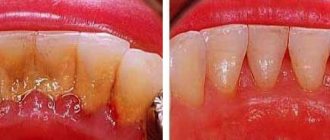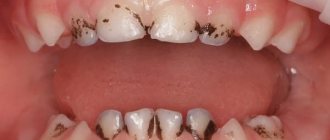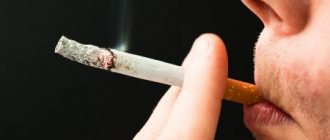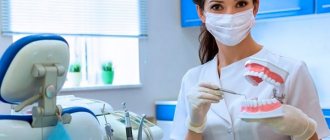Black plaque on teeth, or Priestley's plaque, occurs for various reasons. It may indicate caries, gastrointestinal problems, enamel diseases, or simply poor oral hygiene. It often appears in children aged 2-3 years. In this article we will tell you what to do if your child’s teeth become black.
In this article
- Black plaque on children's teeth: causes of formation
- A child has black teeth - what to do?
- Black teeth in children: possible complications
- Other types of plaque depending on color
- Prevention of dental plaque in children
Black plaque on teeth can appear suddenly at any age, but, according to statistics, it is 8-10 times more common in children. It looks like an uneven border of a dark color, almost black, running along all the teeth closer to the gums. In rare cases, it appears as a small spot or blackhead, often forming on the inside of the teeth.
This symptom is also called Priestley's plaque in honor of the scientist who first described it. He also named the possible reasons for its formation. The danger to health is not so much the plaque itself, which is not a pathology, but a symptom, but rather the disease that provoked its appearance.
What is Priestley's plaque
Plaque on baby teeth of a yellowish, black or brown color appears in a child when bacteria actively multiply in the oral cavity. Priestley's plaque is often seen at an early age, but can also occur in older children. When deposits appear, teeth lose their attractiveness, which can negatively affect the child’s psychological state. If symptoms of this unpleasant phenomenon develop, you should immediately contact your dentist to eliminate Priestley’s plaque in children.
How to detect dark plaque in time
- regularly examine the child’s oral cavity independently;
- do not postpone scheduled visits to the dentist.
It must be taken into account that Priestley plaque on the teeth often accumulates slowly, which is why the child gets used to the stains on the enamel and does not tell his parents about them. Darkening of teeth can occur quickly, literally overnight. Reactive appearance most often occurs during illness, accompanied by intoxication, dehydration and increased body temperature. This is due to the fact that the child’s body reacts sharply to various changes in diet, the functioning of internal organs and in external conditions.
Deposits most often occur at the age of 2-3 years. However, they can also appear on the very first milk teeth of a one-year-old child. Or it could affect the baby teeth of a younger teenager who haven’t had time to change. The darkening may also spread to permanent teeth.
Causes of black plaque in children
The main causes of black plaque on teeth are:
- Priestley plaque is the main cause of deposits. Growing up, the child gets rid of this problem, since plaque almost never settles on permanent teeth. This phenomenon does not harm health and is characterized as a purely aesthetic defect.
- Tooth decay is a serious disease that can lead to tooth loss. The carious process is accompanied by yellowing and subsequently blackening of the tooth enamel. When the first symptoms appear, you should immediately consult a dentist.
- Dysbacteriosis is a disease that leads to the appearance of dental plaque due to disturbances in the functioning of the digestive system. The causes of the disease are poor diet, long-term use of medications, chronic diseases affecting the liver or intestines.
- Oversaturation of the body with iron. Prescribing iron-containing medications to children leads to the formation of both black plaque and deposits that are dark purple or brown in color.
In addition, teeth can darken due to a lack of calcium in the body caused by some disease. In general, the exact cause will be revealed during an examination by a dentist.
Removing dark plaque from a child
Priestley's plaque was removed using ultrasound. For children who do not really like brushing their teeth using the Air Flow method, soft plaque is removed with special brushes and pastes. After professional cleaning, teeth are polished, become smooth, and less plaque settles on the enamel.
The enamel was strengthened using Tooth Mousse cream. The active components of Tuss Mousse make teeth enamel stronger, protecting teeth from caries.
There is no longer a single dark stain on your teeth!
What does ignoring the problem lead to?
Failure to promptly contact a dentist when plaque appears on baby teeth leads to the following negative consequences:
- development of the inflammatory process;
- bleeding gums, which occurs if the child eats or brushes his teeth;
- the likelihood of developing diseases such as caries, stomatitis and periodontal disease increases;
- milk teeth with a black coating are very unaesthetic, which is fraught with the development of complexes in the child;
- deposits may be accompanied by bad breath.
Black teeth in children: possible complications
Black teeth look unsightly. In childhood, this can affect self-esteem. Also, a person with this problem has bad breath. In addition, ignoring this symptom can lead to a number of complications. Among them:
- caries;
- periodontitis;
- increased sensitivity of teeth;
- bleeding gums;
- gingivitis.
To eliminate plaque and prevent its reappearance, it is enough to simply teach your child to follow the rules of hygiene. But it’s better not to take risks - get tested and rule out bad options.
Preventing the reappearance of black plaque on teeth
Prevention of plaque formation includes:
- Regular dental and oral care. For babies, their gums are cleaned using cotton pads and special silicone tips. When the baby turns two years old, he needs to be taught to properly brush his teeth with a brush and toothpaste, as well as to regularly rinse after meals.
- Balanced diet. Your child's diet should include fewer sugar-laden foods and more natural fruits and a variety of vegetables.
- Timely limitation of the use of pacifiers and bottles. Long-term use of these items leads to the appearance of malocclusion, the development of a certain dependence, and the formation of so-called “bottle caries.” If a child can do without a pacifier and bottle, they should be disposed of.
In addition, you should constantly monitor the state of the child’s immune system and support it with the help of vitamins, which have a beneficial effect on the health of the teeth and the whole body. If you follow these simple recommendations, your child will always delight his parents with his beautiful and healthy smile.
Diagnosis and treatment methods of Priestley plaque
The appearance of black plaque can be the result of various diseases. In order to prevent them from starting and to prevent the development of complications, it is necessary to carry out a number of diagnostic measures. Even if a small spot appears on a tooth, you should visit a doctor and undergo laser diagnostics.
If it is caries, then at an early stage of development it is much easier to cure. In addition, the doctor may prescribe additional tests: blood and urine tests. Depending on the results obtained, appropriate treatment methods are selected:
- If problems with the gastrointestinal tract are identified, it is necessary to review the child’s nutritional system. In this case, a special diet is prescribed and some foods are excluded from the diet.
- Lack of calcium or excess iron can be easily treated by taking corrective medications and eating certain foods in greater or lesser quantities.
- When identifying caries at an early stage , dental procedures such as silver plating or fluoridation can help. The doctor treats the teeth with a special solution, which helps prevent further development of the disease and wait for healthy permanent teeth.
- Common Priestley plaque can be removed by professional cleaning by a doctor. But, unfortunately, this is not a guarantee that it will not appear again after a while.
If stains or plaque on the teeth cause pain or discomfort to the child, fillings are used to preserve the teeth and eliminate discomfort.
Causes and prevention
The best way to get rid of such an unpleasant phenomenon is to prevent it in time, and for this you need to find out how it appears.
The most common reason why black plaque appears on teeth is lack of hygiene. If you don’t brush your teeth regularly, don’t remove dirt from hard-to-reach areas and neglect procedures, plaque formation is inevitable.
The remaining “unattended” bacteria accumulate in the oral cavity, first on the inside of the dental units, in the cervical area, then move to the front walls, harden, turning into tartar, and darken over time. This is why black plaque on your teeth cannot simply be removed with toothpaste or a hard brush.
At the same time, pathogenic microorganisms can penetrate deep into the tooth structure, affect the pulp and root, and cause caries, periodontal disease, gingivitis and other pathologies. For prevention, it is recommended to undergo hygienic cleaning at the dentist regularly (once every six months).
Products containing caffeine and nicotine also cause black plaque to appear on teeth. They provoke the formation of pigment plaque, change the color of the enamel, and it is quite difficult to get rid of it.
To restore the whiteness of your teeth, you will most likely have to resort to a whitening procedure.
The greatest discomfort is caused by dark plaque on the front teeth in the smile area. And the presence of bacterial deposits or stone on the enamel accelerates and intensifies the darkening process.
Other reasons include:
- excessive consumption of foods high in iron;
- use of rinses containing phenols;
- metabolic disease;
- diseases of the digestive tract;
- hormonal disbalance;
- diabetes;
- bacterial diseases of the body;
- taking certain medications;
- regular toxic exposure to metals.
If dark brown plaque on your teeth appears in the form of spots, this may be a symptom of carious lesions, in which case you should immediately consult a specialist.
What to do with a child's yellow teeth
The choice of treatment technology depends on the disease and the phase of its development. Light yellowness can be removed with special pastes. More severe cases require professional cleanings by a dentist. For older teenagers, ultrasonic teeth cleaning is used. If there is a serious need to use a skeler, the procedure is carried out delicately and with caution. The cost of procedures in our center is affordable, as we always pursue a reasonable pricing policy.
At the appointment with our dentist, the child will be mentally prepared for therapy in order to prevent fear. The level of oral hygiene is determined by special indicators. Professional cleaning procedures are painless. This can be a rotating brush, which works well on both the oral and vestibular sides. After such manipulations, as a rule, a hygiene lesson is conducted in a playful way.
Stages of plaque formation
Plaque on the teeth of children does not form immediately, but sequentially, going through several stages:
- Pellicle formation. This is an organic film of minimal thickness, the basis of which is the glycoprotein components that make up human saliva. This film is characterized by the absence of microorganisms in it.
- Precipitation of bacteria. Over time, the number of microorganisms consistently increases due to the appearance of new films, which in turn causes an increase in the thickness of deposits formed on the surface of the teeth.
- Actions of anaerobic agents. In air conditions, bacteria are active, resulting in the release of acid. This, in turn, affects tooth enamel, washing away minerals from it.
- Formation of an anaerobic environment. At this stage, the density of deposits increases to a state in which it is not possible to remove them with saliva or rinsing the mouth. The enamel is actively losing minerals.
The rate of formation of deposits on teeth is largely individual. It depends on the composition of saliva, the intensity of epithelium changes, a person’s tendency to inflammation, and so on.
Preventive measures
It is important to provide your child with proper dental care. Immediately after the first incisor appears on an infant, it is necessary to thoroughly clean it with a special brush-finger 2 times a day. It is necessary to ensure proper oral care even before teething begins. For this purpose, wipe the gums with a sterile piece of gauze soaked in boiled water. Other preventative measures:
- limiting the consumption of sweets, confectionery, carbohydrate foods, acidic foods and drinks;
- regularly visit the dentist with your child - at least 2 times a year, ideally - every 3-4 months;
- Give your baby vitamin complexes after illnesses and during periods of active growth - only as prescribed by the pediatrician.
It is important for the expectant mother to follow a diet and not take medications without the doctor’s approval.
How to get rid of it
You won’t be able to get rid of black plaque on children’s teeth at home on your own. The use of aggressive products or methods can cause serious damage to the enamel. To restore the color of teeth, it is necessary to determine the exact cause of the pathology.
If the blackening of teeth is not associated with dental diseases, then treatment is carried out comprehensively. The dentist performs all manipulations to clean the enamel, and another specialist deals with the main disease.
If the cause is unknown or the disease is chronic, the child’s teeth may periodically darken again. Unlike ordinary yellow or brown plaque, black deposits create a pronounced aesthetic defect, so it cannot be done without the help of a dentist.
Eliminating white spots on teeth: what you can do at home
If the problem lies in an excess or deficiency of fluoride, you may need to change the water or install a filter that will remove this element. For fluorosis, toothpastes purchased for a child should not contain fluoride.
If a child is one year old and already has white spots on his teeth, his diet needs to be adjusted. It is important that in addition to breast milk, the diet contains foods containing calcium and vitamins, such as cottage cheese and vegetables. If the baby is on artificial nutrition, you should make sure that he does not fall asleep with a bottle in his mouth. Remains of sweet milk formula can trigger the development of so-called bottle caries.
It is also necessary to pay great attention to oral hygiene. Parents should take care of their teeth first. And when the baby becomes more independent, you need to teach him the basic rules of hygiene. Your doctor will also give you recommendations for care.
The main dangers of dental plaque
Such deposits, regardless of their color, are a breeding ground for various bacteria, so they pose a danger to the child and require prompt removal. At the same time, the waste products of such microorganisms have an acidic environment, which has a destructive effect on tooth enamel.
In this case, the following diseases may become further development of plaque:
- Destruction of enamel;
- Formation of tartar;
- Caries;
- Gingivitis (inflammation of gum tissue);
- Periodontitis.
Professional teeth cleaning
One of the main methods of eliminating black plaque on teeth is professional enamel cleaning.
At Martinka Dentistry, depending on the age of the patient, professional hygiene is carried out using the following methods.
- Hygienic. (Children under 3 years old). The procedure is performed using professional paste and brush.
- Airflow (from 3 years old). A hardware method for removing plaque using an air stream containing soda crystals.
- Ultrasound (from 16 years old). Cleaning teeth from plaque occurs under the influence of ultrasonic waves.
The advantage of professional teeth cleaning is the achievement of a comprehensive effect. As a result of the procedure, plaque is removed even in hard-to-reach areas, teeth are polished and the enamel is whitened by several tones.
Yellowness of teeth in a child 1-3 years old
It happens that this problem is not given due attention. Parents mistakenly believe that a one-year-old child with his baby teeth does not need a dental examination. After all, these units are a temporary phenomenon, so there will be no harm from their pathology. In reality, everything is completely different. If you do not visit the dentist in a timely manner, then problems in the form of darkening of the crowns in the future will develop into serious anomalies of the oral cavity. What should parents do?
- Once the incisors appear, they need to be wiped with a damp cloth after feeding.
- When your child turns 1 year old and has 8 units, start cleaning them with a toothbrush without toothpaste. It should be small in size with nice bristles.
- After the child turns 2 years old, begin to teach him to be independent in matters of oral hygiene, then at 2.5 years he will be able to carry out this procedure himself.
Consult your doctor about the choice of baby toothpaste. After all, it is very important to approach it correctly. Do not use products that are oversaturated with flavors and dyes.










